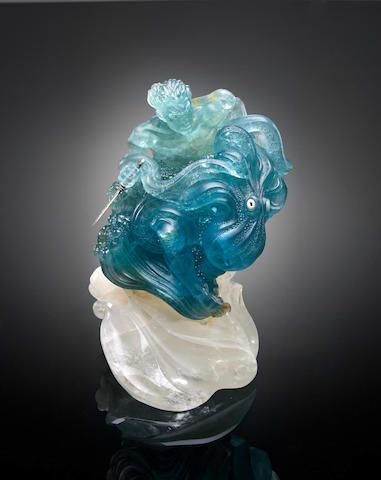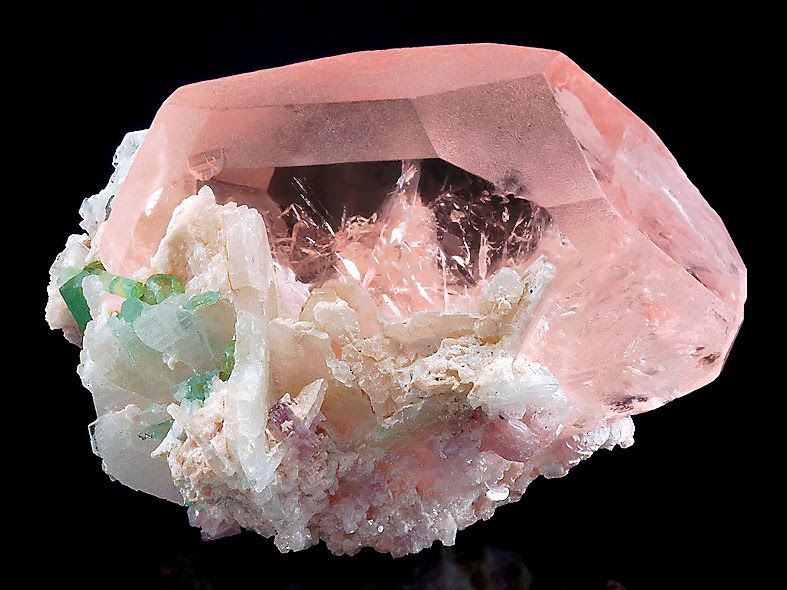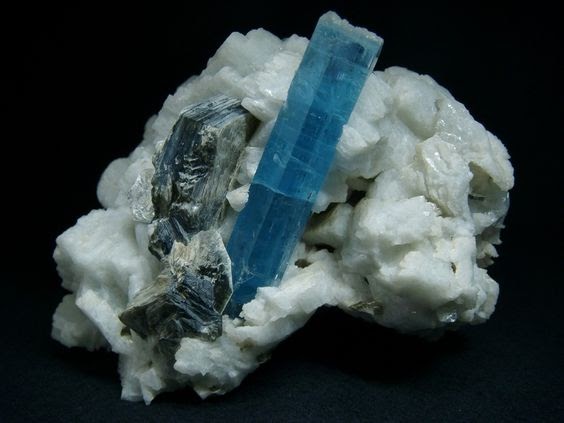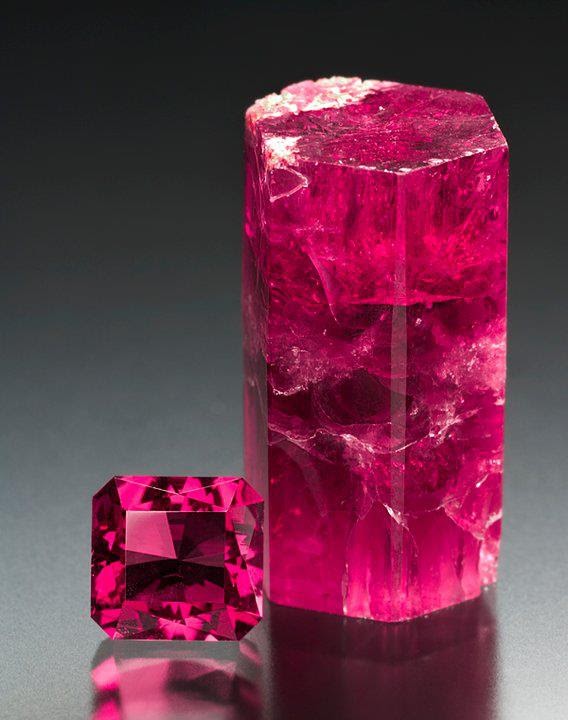Other Beryls
Beryl Varieties

The beryl mineral species comes in a variety of colors like pink, red, green, blue, brown, and black. Most gem-quality beryls come from pegmatites, a mineralogical formation that typically produces large gems visually inclusions free. Despite their viability in jewelry, they remain mostly known as collector gems with the exception of aquamarines. Aquamarines fade to colorless with enough exposure to the sunlight.
Phenomena
Occasionally beryl exhibits features like a cat’s eye, formally called chatoyancy. This is the main phenomena they may commonly show, but one particularly unique case displays a six-rayed star due to a unique arrangement of inclusions. This asterism phenomena should not be expected in emeralds.
The various types of beryl discussed in this section are:
- Aquamarine
- Green Beryl
- Morganite
- Maxixe Beryl
- Heliodor
- Red Beryl
- Goshenite

Aquamarine
Aquamarines are the best-known beryl after emeralds. The name is derived from the latin for water (aqua) and the sea (marine), coming in a range of color from greenish blue to a bright sky blue. It is formally distinguished from emeralds and green beryl by being primarily blue in color. However, the exact point where the color is greenish blue or bluish green differs between countries. What may qualify as an emerald in America might qualify as an aquamarine in Italy.
Faceting & Carving

These sea-blue gems often grow large and clear, making them ideal for faceting. Since they often only show a lighter blue color, larger pieces are more desirable to display deeper blues. It also makes them ideal gems for carving, like with Dom Pedro aquamarine, or this carved aquamarine of Poseidon (Greek god of the ocean) fighting an octopus.
Their clear nature also makes aquamarines ideal for heat-treating to display improved colors. The specific absence of liquid inclusions is important, because otherwise the liquid will cause fractures to rupture inside the aquamarine and damage it instead. Aquamarines cannot heal their fractures the way rubies and sapphires can.
Their clear nature also makes aquamarines ideal for heat-treating to display improved colors. The specific absence of liquid inclusions is important, because otherwise the liquid will cause fractures to rupture inside the aquamarine and damage it instead. Aquamarines cannot heal their fractures the way rubies and sapphires can.
Green Beryl
Green beryl is not to be confused with emeralds since they are the same gem material colored by the same trace elements (chromium and vanadium). What officially distinguishes emeralds and green beryl is usually their tone, with light green being green beryl, and vivid to dark greens being emeralds. The precise distinction between the two is not universally recognized between different countries, despite the available guidelines.

Saturation, or how rich and vivid the color is, plays a role too. However, most gem vendors do not bother with gems that are not vividly colored, regardless of whether they are emeralds or sapphires.
Green Beryl Examples
Brazilian Emeralds and Green Beryl

There was a time when emeralds from Brazil were sold as green beryl because they were colored by vanadium instead of chromium like the Colombian emeralds. Eventually researchers from the Gem Trade Laboratory made an announcement on this in 1963. They had come to the agreement that emeralds can be colored by either of the elements or a combination of the two, leading Brazil and possibly other locations to be acknowledged as emerald producers.
This bit of emerald vs. green beryl history does not help with the distinction between the two. Judging based on faint color distinctions can be an arbitrary decision for in-between colors. In addition to Brazil, Zimbabwe and Australia produce green beryl too.
Morganite

Beryl that is pink, rose, salmon, or peach-colored go by the trade name of Morganite. Even the best specimens only have a moderate to low pink saturation, never vivid pinks and reds as seen in pink sapphires and rubies. This gem was originally discovered in Madagascar, but has been found in other locations like Brazil, California, Afghanistan, and even in the United States.
This particular variety is named after the legendary banker and collector extraordinaire, J. P. Morgan.
Morganite is colored by traces of manganese. Due to their lightly saturated nature, they must be faceted in large carat weights in order to display nice color

Maxixe
The dark blue colors of maxixe were originally discovered in 1917 in a mine of the same name in Brazil. Initially enthralled with the color, gem dealers became disenchanted with it when they learned how quickly the color fades.
The color in maxixe beryl can be restored with irradiation, but this treatment is not permanent.
When other varieties of beryl such as goshenite (colorless beryl), morganite, and aquamarines are irradiated, they will reach the deep blue maxixe colors. Upon exposure to light or heat the dark blue will fade again.
Heliodor
The trade name of yellow beryl is heliodor, translating from Greek as “Gift from the Sun”. The yellow color comes from traces of iron. While the examples below display ideal color, heliodor can also be a greenish yellow, orangish yellow, or brownish yellow. Like morganite, they only display light to medium tones and saturations, rarely if ever reaching highly vivid lemon-yellow colors. This low saturation also makes larger sizes of this gem ideal to display color. The yellow can look washed-out in smaller specimens otherwise.

Despite its greater rarity than aquamarine, heliodor does not command the same price. Due to its eye-clean nature, it is often heat-treated to produce pleasant aquamarine colors. Sometimes colorless beryl is irradiated to these colors too.
Red Beryl (also known as Bixbit)

Red beryl is the rarest variety of beryl. It displays deep, vivid reds unlike most of its mineral cousins except for emeralds. It is also known under the name Bixbite, named after Maynard Bixby for discovering it 1897. This name has led the gem to be confused with Bixbyte, also named after Bixby. As a result the gemological community officially refers to it as red beryl. They have only been found in the area around the Wah Wah mountains in Utah to-date, usually in small sizes yielding around 0.2 carats. Furthermore, the amounts mined are sporadic and unstable. Despite their high appeal, the compounded scarcity of red beryl restricts them almost exclusively to being a collector’s gem.
Color
Thanks to higher concentration of manganese, red beryl manages to reach the deep red saturation that morganite crystals never achieve. The greater saturation also makes the pleochroism, or the way beryl splits light more obvious. Depending on the angle and base coloration of the beryl, faceting it in the wrong direction could show a purplish red or orangish red instead of a pure, vivid red.

Red beryl is very similar to emeralds not only in terms of color saturation, but their highly included nature too.
They can display all manner of inclusions like crystals, three phase inclusions, needles, hollow tubes, fingerprints, and color zoning. This means they receive the same types of treatments as emeralds with oils and resins to improve clarity.
Beware treatments for durability, since this usually indicates a gem that has been glued together and cut. Eventually the glue dries out and the gem literally falls apart.
Goshenite

Goshenite is colorless beryl, and unlike the other beryl varieties lacks color and any saturation. This gem was originally discovered in Goshen, Massachusetts. It is not a popular gem for jewelry since it lacks the luster and colorful fire of diamonds, which comprises more that half of the entire gem industry. Furthermore, all colorless gems used in jewelry are compared against diamonds. This is in no way a fair comparison either, since diamonds are just as different from goshenite as they are from sapphires. All these gems have different hardness, crystal structures, core elements, and are even cut differently on a polishing wheel.
Goshenite forms similarly to its mineral cousins in a hexagonal growth habit, though can show slightly different crystal growth habits. For example, goshenite can either end in a point, or have a flat top like a hexagonal table.

